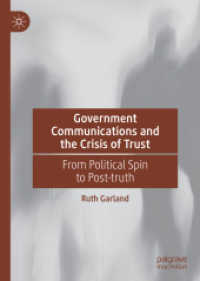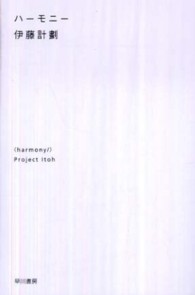- ホーム
- > 洋書
- > ドイツ書
- > Social Sciences, Jurisprudence & Economy
- > Politics, Society, Work
- > public administration
基本説明
Presents a theory developed by the author to combine the recent insight into empirical data with mathematical models in freeway traffic research based on dyanamical non-linear processes.
Full Description
This monograph is devoted to a new approach to an old field of scientific investigation, freeway traffic research. Freeway traffic is an extremely complex spatiotemporal nonlinear dynamic process. For this reason, it is not surprising that empirical traffic pattern features have only recently been sufficiently understood. Such empirical features are in serious conflict with almost all earlier theoretical and model results. Consequently, the author introduced a new traffic flow theory called "three-phase traffic theory," which can explain these empirical spatiotemporal traffic patterns. The main focus of this book is a consideration of empirical spatiotemporal traffic pattern features, their engineering applications, and explanations based on the three-phase traffic theory. The book consists of four parts. In Part I, empirical studies of traffic flow patterns, earlier traffic flow theories, and mathematical models are briefly reviewed. Three-phase traffic theory is considered as well. This theory is a qualitative theory. Main ideas and results of the three-phase traffic flow the ory will be introduced and explained without complex mathematical models. This should be suitable for a very broad audience of practical engineers, physicists, and other readers who may not necessarily be specialists in traf fic flow problems, and who may not necessarily have worked in the field of spatiotemporal pattern formation. In Part II, empirical spatiotemporal traffic pattern features are consid ered. A microscopic three-phase traffic theory of these patterns and results of an application of the pattern features to engineering applications are pre sented in Part III and Part IV, respectively.
Contents
1 Introduction.- I Historical Overview and Three-Phase Traffic Theory.- 2 Spatiotemporal Pattern Formation in Freeway Traffic.- 3 Overview of Freeway Traffic Theories and Models: Fundamental Diagram Approach.- 4 Basis of Three-Phase Traffic Theory.- 5 Breakdown Phenomenon (F?S Transition) in Three-Phase Traffic Theory.- 6 Moving Jam Emergence in Three-Phase Traffic Theory.- 7 Congested Patterns at Freeway Bottlenecks in Three-Phase Traffic Theory.- 8 Freeway Capacity in Three-Phase Traffic Theory.- II Empirical Spatiotemporal Congested Traffic Patterns.- 9 Empirical Congested Patterns at Isolated Bottlenecks.- 10 Empirical Breakdown Phenomenon: Phase Transition from Free Flow to Synchronized Flow.- 11 Empirical Features of Wide Moving Jam Propagation.- 12 Empirical Features of Moving Jam Emergence.- 13 Empirical Pattern Evolution and Transformation at Isolated Bottlenecks.- 14 Empirical Complex Pattern Formation Caused by Peculiarities of Freeway Infrastructure.- 15 Dependence of Empirical Fundamental Diagram on Congested Pattern Features.- III Microscopic Three-Phase Traffic Theory.- 16 Microscopic Traffic Flow Models for Spatiotemporal Congested Patterns.- 17 Microscopic Theory of Phase Transitions in Freeway Traffic.- 18 Congested Patterns at Isolated Bottlenecks.- 19 Complex Congested Pattern Interaction and Transformation.- 20 Spatiotemporal Patterns in Heterogeneous Traffic Flow.- IV Engineering Applications.- 21 ASDA and FOTO Models of Spatiotemporal Pattern Dynamics based on Local Traffic Flow Measurements.- 22 Spatiotemporal Pattern Recognition, Tracking, and Prediction.- 23 Control of Spatiotemporal Congested Patterns.- 24 Conclusion.- A Terms and Definitions.- A.1 Traffic States, Parameters, and Variables.- A.2 Traffic Phases.- A.3 Phase Transitions.- A.4Bottleneck Characteristics.- A.5 Congested Patterns at Bottlenecks.- A.6 Local Perturbations.- A.7 Critical and Threshold Traffic Variables.- A.8 Some Features of Phase Transitions and Traffic State Stability.- B ASDA and FOTO Models for Practical Applications.- B.1 ASDA Model for Several Road Detectors.- B.1.1 Extensions of ASDA for On-Ramps, Off- Ramps, and Changing of Number of Freeway Lanes Upstream of Moving Jam.- B.1.2 Extensions of ASDA for On-Ramps, Off- Ramps, and Changing of Number of Freeway Lanes Downstream of Moving Jam.- B.1.3 FOTO Model for Several Road Detectors.- B.1.4 Extended Rules for FOTO Model.- B.2 Statistical Evaluation of Different Reduced Detector Configurations.- References.







